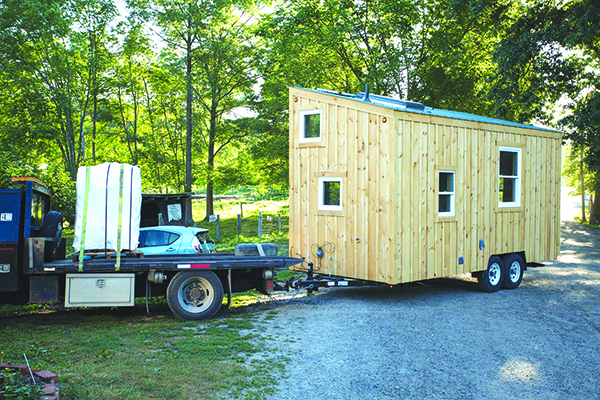Small living spaces have been gaining popularity in recent years, and are now on Natick’s radar. From compact houses under 1,200 square feet to so-called “tiny homes” that are often set on wheels, alternative dwellings are poised to make a big impact on the housing market. They make good use of limited space, allowing more people to settle in residential areas for lower costs, and help people live in more eco-friendly and sustainable ways that simplify their lives.
Re-Designing Suburbia
Natick resident Ganesh Ramachandran has a vision for better housing options throughout the suburbs of Boston. “As an urban designer, having lead national and international planning efforts for more than 15 years, I was looking for an opportunity to serve my town in my area of expertise,” he said.
Ramachandran was a board member of the Natick Affordable Housing Trust Fund and Community Development Advisory group, and was nominated to work on the Tiny House Study Committee in 2015. Despite its name, the committee was interested in smaller homes as alternatives for typical single-family and apartment buildings instead of advocating for more extreme dwellings, often near the size of a shed.
“As a committee, we wanted to study a pragmatic building type that is more contextual and compatible to diverse user needs,” Ramachandran explained. “Our study was focused on detached dwellings with a gross built area between 600 and 1,200 square feet.”
These small homes appeal to multiple generations, each with their own motivations for seeking alternative housing. “The Baby Boomer generation is looking to downsize, and millennials are more interested in living in walkable neighborhoods with access to public transportation rather than in large homes,” he elaborated. These homes also offer more affordability for both demographics.
More Small Homes Ahead?
Zoning regulations in the suburbs currently favor large homes for individual families, set in neighborhoods that use cars as their main form of transportation. However, with changes in regulation, Ramachandran believes that Natick, and greater Boston at large, can set a new standard for housing and community development.
“Smaller homes reduce the resources needed to build and maintain housing, while preserving and sustaining our rapidly changing communities,” he explained. “They are about leveraging the power of design and regulations to provide alternative choices, both for those who consume less, and those that have less to spend.”
The committee finished its efforts by completing its study in 2016, and the findings are now being considered by the Master Planning team and the Natick Affordable Housing Trust Fund, which will decide Natick’s response to the research. The full report can be downloaded at www.tinyurl.com/smallhouses.
Making a
Tiny House a Home
Kori Feener, also a Natick resident, lives in a tiny home located on the grounds of the Natick Community Organic Farm (NCOF) located at 117 Eliot St. To prepare for her move, Feener needed to downsize significantly, but she found she enjoyed the process. “Instead of filling my life with stuff, I am focused on experiencing events, rather than building material capital,” she explained.
Although her small-scale living space may seem radical, Feener never feels cramped. She sometimes experiences claustrophobia in small spaces, such as in elevators and in crowded bars, but not in her home. It is designed with a high roofline in the main living space, and there are many windows, enabling her to see outside, creating an open feel.
Her home also matches her lifestyle. “As a freelancer, documentarian and journalist who mixes traveling and working from home, I love the short commute,” she said. “Most importantly, I am so very focused on climate change. Being able to lower my own footprint by living in an efficient home, cutting back on my contribution to consumerist capitalism and supporting local agriculture is a win-win scenario for me.”
Because she is living on NCOF land, there is an element of community that is present in Feener’s life both in and around her home. Through the farm, she offers tours of her tiny house, enabling visitors to experience the space for themselves. She does not see herself living in a standard-sized home again.
“I don’t think my idea of regular is like the houses I see around me. I think most of them are too large, and see a tendency for space to be filled with things when we have too much of it,” she said. “But, I think the sustainable mindset is possible, no matter how many square feet you call home.”

Issue Date:
February, 2017
Article Body:
